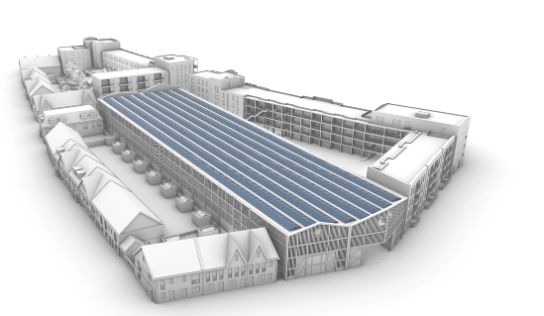Feasibility study for a solar PV car park with charging infrastructure and battery storage

Feasibility study for a solar PV car park with charging infrastructure and battery storage
The Energy Performance of Buildings Directive (EPBD III) requires charging points to be installed in new buildings. Commissioned by the municipality of Harderwijk, Witteveen+Bos has conducted an exhaustive feasibility study into the application of solar PV, charging infrastructure and battery storage at the Waterfront car park.
As part of the Waterfront area development, the municipality of Harderwijk is transforming the centre of the Veluwemeer area into a recreational, natural and residential area. Part of the Kop van de Stadswerven housing development is a car park with an energy system based on a solar PV installation, charging infrastructure, energy storage system (EOS) and associated electrical infrastructure and systems.
Witteveen+Bos supported the municipality as an advisor to ensure that the energy concept is properly taken into account in the realisation of the parking garage.

Part of this feasibility study, also known as a business case analysis, includes analysing the availability of electricity (grid congestion) until 2030 and after 2030, the development of the number of EVs, charging needs and charging behaviour in Harderwijk, the construction of the charging infrastructure, advice on the organisational form of the charging points and TCO analysis.
Based on the insights gained, the programme of requirements was supplemented at the request of the municipality of Harderwijk.
The following aspects were investigated/elaborated in this feasibility study/business case analysis:
- Current grid capacity analysis with grid operator
Including timeline and power specification. - Solar PV roof design
(Multi-criteria analysis based on four parameters for the purpose of a variant study):
1. Minimal negative impact on the surrounding buildings
2. Appropriate connection to architectural design
3. Minimal implications for the construction
4. Revenue from solar panels - Grid integration of solar PV
Until 2030/after 2030 implications of grid availability for offtake and feed-in capacity - Expected development of EVs and charging demand
Parking balance Waterfront
EV adoption Harderwijk (three scenarios)
Charging needs per user per session (residents, workers and visitors) - Electricity consumption of parking garage
- Organisation of public charging points
Analysis and advice on chain organisation (with the important stakeholders being energy supplier, charging station supplier and charge point operators (CPO). - Advice on energy concept
- Functional specifications for main functionalities of energy concept
Technical: type of charging station, cable system, energy storage system, EMS, type of solar PV inverters
Administrative: HBE administration - Energy concept cost estimate
TCO analysis
Sensitivity analysis - Battery storage
Cost-benefit analysis
Business case for battery storage
Battery storage preconditions
More information?
